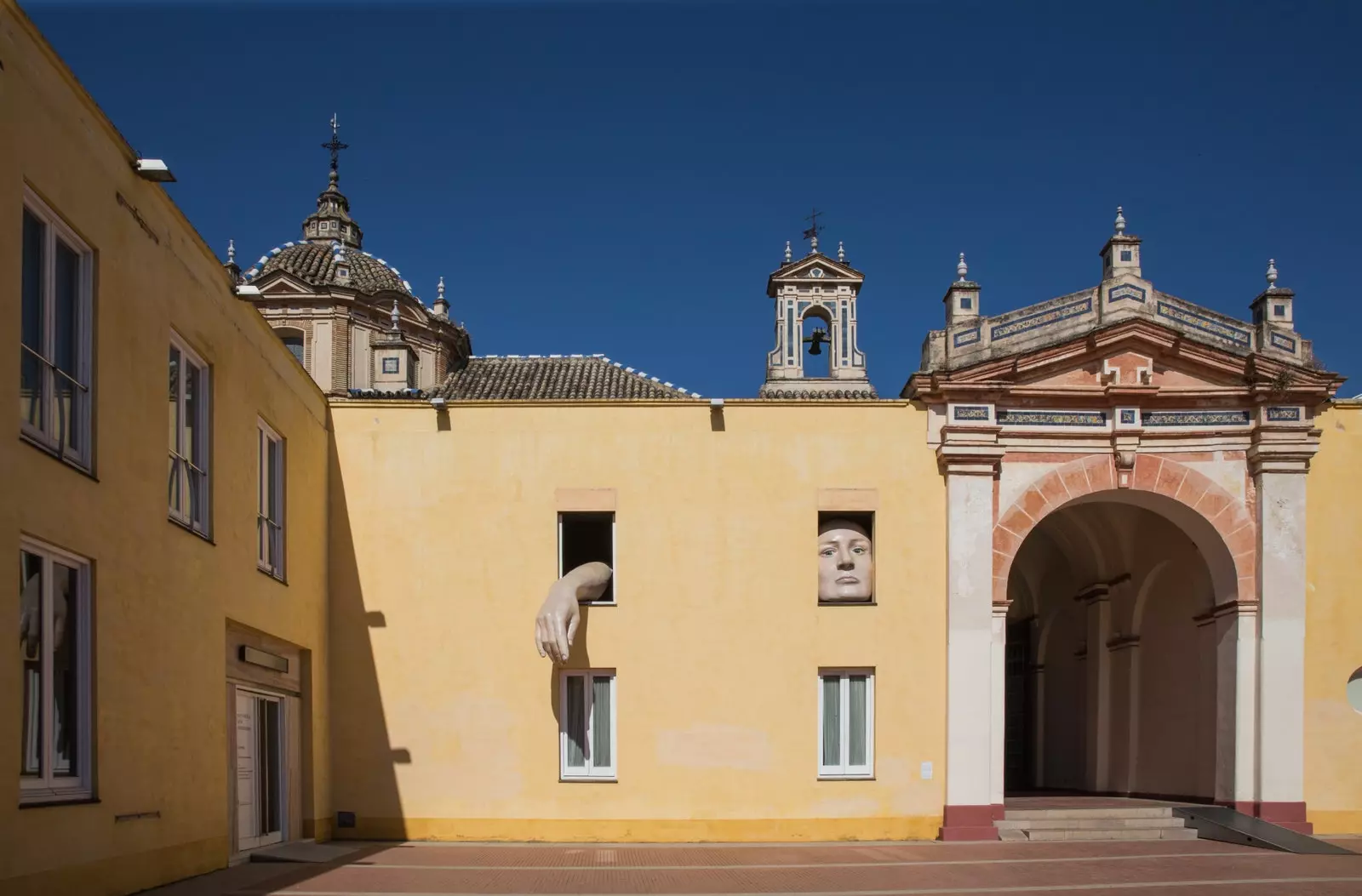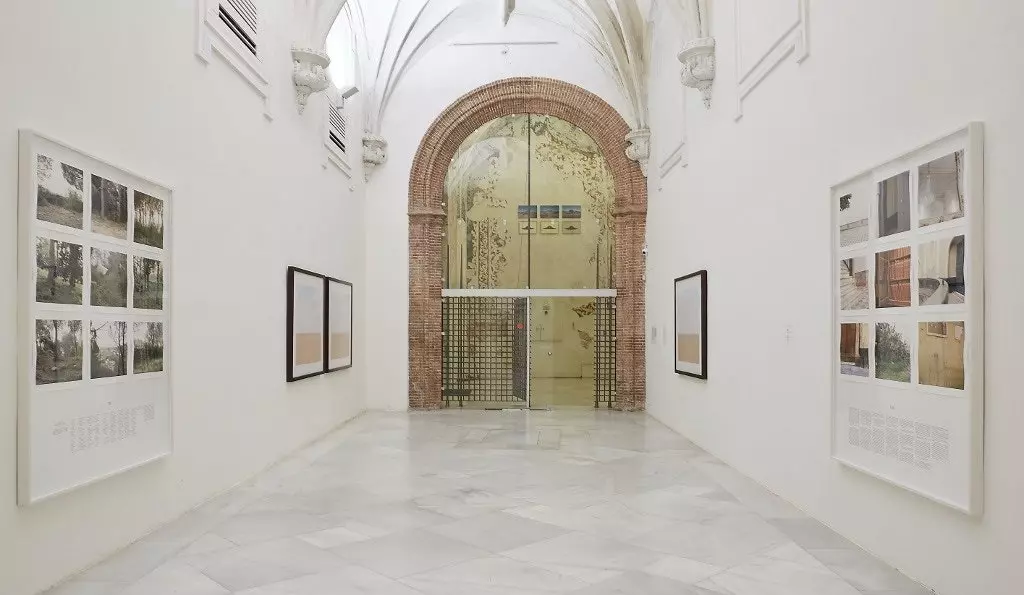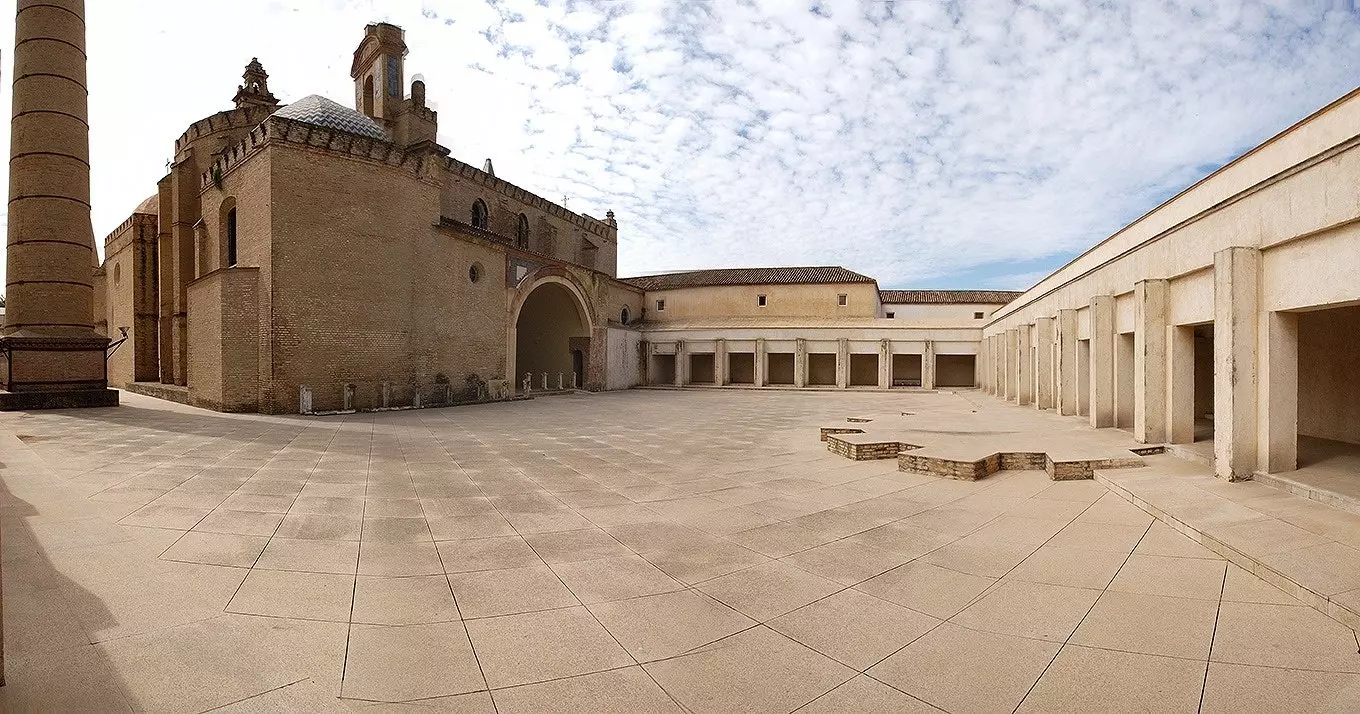
This is how 'Alicia' receives us in the wonderland that is La Cartuja de Sevilla.
You look at it from where you look at it, that small-great Alicia with a lost look wedged between the windows of the CAAC —Andalusian Center for Contemporary Art— gives off a certain air of melancholy. Perhaps because with it Cristina Lucas, from Jaén, author of this wonderful —and immense— work that pays homage to the protagonist of Lewis Carroll's novel, intended to denounce the confinement and oppression to which many women in the world are subjected.
Be that as it may, Alicia ceased to be only the character of a story to also become the star of the old Monastery of the Seville Cartuja, one of the heritage treasures of the island that bears her name. Island, by the way, fictitious: embraced by the Guadalquivir, its waters never really surround it completely.
This is precisely where our walking through that other Seville: the one that goes beyond the cathedral or the Giralda, emblems that claim the attention of the whole world, to show us that even on this other side of the river the city has a lot to offer. It was already demonstrated by the much-remembered Universal Exhibition of '92. Although we'll talk about that later.

One of the rooms of the CAAC (Andalusian Center for Contemporary Art), in Seville.
ON THE ISLAND
We get down to work, we say goodbye to Alicia, and we start stroll through the gardens and orchard of the monastery, founded by Carthusian monks in the 15th century. We are in a space made up of more than 24 hectares steeped in history: Christopher Columbus himself used to stop by his hostel, from where he also organized the second expedition to the Americas. What's more: after he died, his remains rested here for around 30 years. The church, the beautiful chapels and the cloister also remain from that time.
But besides history, The Cartuja Monastery is above all —and above all— culture: past and present commune in this space in a wonderful way thanks to art, not only because the aforementioned CAAC is located here, which offers a wonderful permanent collection as well as interesting temporary exhibitions with artists such as Ai Weiwei, but because the concerts and festivals that take place in its gardens —starting with Interstellar itself and ending with the famous Electronic Lunch or the jazz that sets the scene on Sundays— are infinite.
As if all this were not enough, in the museum's courtyards there is something else that powerfully draws our attention: they are the towering chimneys of the old Chinese china and porcelain factory that the Marquis of Pickman ordered to be built in 1841. That Briton did not think of a better place in the world to establish his mythical business, and more beautiful, than this: thus he gave a new life to the monastery, where the ovens were kept in operation until 1982.

One of the patios of the CAAC (Centro Andaluz de Arte Contemporáneo), which occupies the old Monastery of La Cartuja, in Seville.
THE TRACK OF 92
The point is that the Isla de la Cartuja has always gone through ups and downs, experiencing long moments of abandonment and oblivion. It was precisely going through one of its most decadent stages when The Universal Exposition of 1992 arrived and the nice Curro —colored crest included— to save her. La Cartuja then became the place to be: The whole planet stared at this little piece of Seville.
That event, which lasted throughout the summer—oh, poor those 42 million visitors who knew well what it was like to live Seville at 40 degrees—was a before and after in the city. The commemoration of the 500 years of the discovery of America resulted in an unprecedented renovation of Híspalis: bridges were built, infrastructures were modernized and buildings of extraordinary architecture were built, including 120 pavilions in which up to 108 countries were represented.
And what happened to those works of art made into buildings? Well, even though the vast majority were demolished or moved Once the exhibition was over, there were others that remain standing today, delighting nostalgics.
And yes, we admit it, there is one that we love: the Moroccan pavilion was a gift from King Hassan II to the Government of Spain and ended up becoming the Foundation of the Three Cultures of the Mediterranean, a place where two lands come closer to through activities such as talks, workshops, guided tours or concerts, and a jewel of Moroccan craftsmanship designed by Frenchman Michel Pinseau. Of course: dozens of artisans from the other side of the Strait were responsible for making it a reality, that's why the carved wood work, the meticulousness with which the plasterwork is sculpted, the incredible dome or the details of its mosaics are simply hats off.
But there is more. Little, but more. The Canadian pavilion, famous in 1992 for the IMAX cinema which caused an authentic revolution, is today the headquarters of the School of Industrial Organization of Seville and Box Cartuja, a modern cultural space that includes an auditorium with capacity for 500 people. The one in New Zealand houses the Institute of Statistics and Cartography of Andalusia. Even a rocket has the Charterhouse! The life-size replica of the Ariane IV, with its 64 meters in height, was part of the Pavilion of the Future.
empty is found the Mexican pavilion, with its giant X and its historic cactus still planted at its feet. Neither does Hungary currently have any use, which together with Spain (today part of the Isla Mágica amusement park), Andalusia (headquarters of the Canal Sur Radio studios), Finland or France (home of El Cubo, a startup accelerator controlled by Fundación Telefónica), was declared Andalusian Historical Heritage.
Santiago Calatrava could not miss, and left his legacy after the Expo as a bridge: the Alamillo , spectacular for its then innovative cable-stayed design, connects with the Cartuja and forms an indisputable part of the Sevillian skyline. But he also designed what was the Kuwait pavilion, which despite causing a furor in its day, today is completely abandoned.
In our particular route to the hunting and capture of pavilions there is no lack of another protagonist of that milestone: the Bioclimatic Sphere, the giant logo of the Expo how well it did its function of cooling down the heated visitors with water vaporizers. No one ever thought that, more than 25 years later, it would still stand in full dignity, reclaiming the memories of the past.
DID SOMEONE SAY THEATRE?
Theater, yes. And also music and museums and shows , that this city does not skimp on wisdom. So after going around the world in a few square kilometers, it's time to call —again— the culture: the one that is lived, felt and defended also on this island.
And the offer is wide, let us warn you: starting with the aforementioned Box Cartuja and adding the Teatro Central, which since its inauguration has been betting on radically contemporary programming which has made it a benchmark at European level. The Cartuja Center Cite, with capacity for four thousand people, also has its place here, as well as the Rocío Jurado Auditorium, while At one end of the Cartuja stands the La Cartuja Olympic Stadium, headquarters of numerous sporting and cultural events and two steps, by the way, from another space —this time, green—: Parque del Alamillo, which with its 120 hectares is a paradise for runners and the most authentic oasis in the city.
And more culture? More culture, the one exhibited in the Navigation Pavilion —yes, “pavilion”: another survivor of 1992, of course—, a building with a peculiar inverted ship design by Vázquez Consuegra which hosts exhibitions always inspired by Seville's relationship with the sea and those historic expeditions.
LIVE, NO. SLEEP, YES.
In the Charterhouse stands out the absolute absence of houses: Nobody lives, what's going on, but they do spend the night. Where? Well, in any of the two five-star hotels that planted their glamor right here.
The first was the Hotel Barceló Renacimiento, which with a design that somehow evokes the New York Guggenheim, its 295 rooms and 25 meeting rooms, is one of the favorites when it comes to organizing conventions.
The second is very young and is on the heights of what has already become another of the architectural emblems of Seville —and of La Cartuja, of course—: the Eurostars Torre Sevilla It occupies the last 19 floors of the magnanimous work of César Pelli and is a beautiful balcony to the city. Although it is clear that its elegant rooms are not the only attraction up there: the pleasure of have a cocktail from its terrace Atalaya Torre Sevilla or enjoy an evening with views in its El Duende restaurant, these are enough excuses to let ourselves be carried away by our most enjoyable side.
Meanwhile below, at our feet, a beautifully scattered city locates in space the last Carthusian claims: still without moving from the island, not even from the Torre Sevilla complex, you can feed the soul based on more art with the exhibitions at CaixaForum Sevilla , located in an original —and striking— building designed by the aforementioned Vázquez Consuegra. Also strolling through the Magallanes Park —by the same architect— is a good idea. Or, why not, give free rein to the consumerist spirit in its modern shopping centre.
Anything else to add? Well, some little thing, yes, but at some point we suppose that we will have to finish this article. So better We pass the baton to the surprise factor, an essential element of any trip. We assume that this will not disappoint us.
